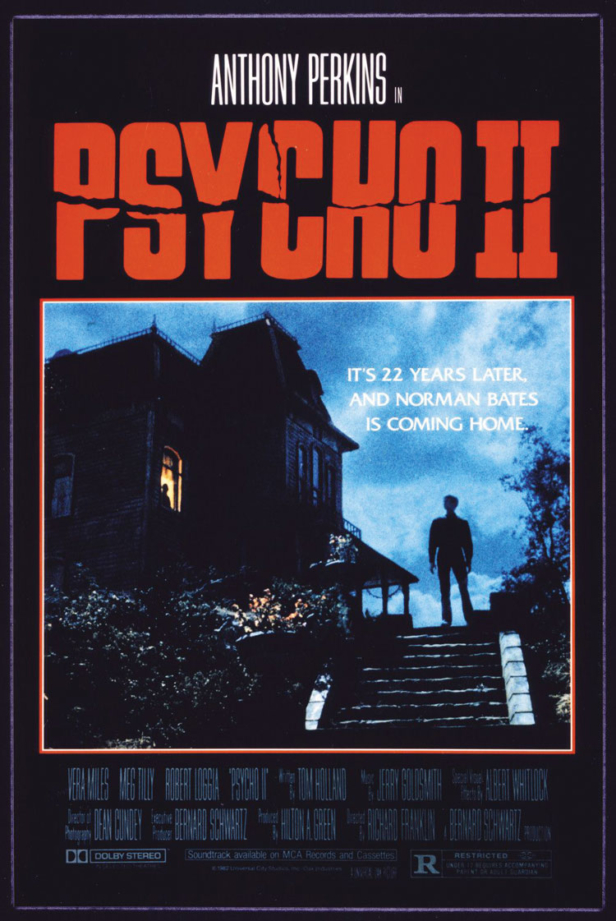American filmmaker Tom Holland, (not to be confused with a certain Spidey actor of the same name) has been thrilling audiences on both the large and small screen for many years. He began his screenwriting career penning the audicious 1983 sequel to Psycho, which lured Anthony Perkins back as Norman Bates. It became a critical and commerical success and helped launch Holland’s subsequent career as a horror filmmaker; writing and directing the original 1985 vampire classic Fright Night, then the equally iconic killer doll horror Child’s Play.
Since then, Holland has directed two Stephen King adaptations and helmed episodes of Tales From The Crypt and notably the ‘We All Scream For Ice Cream’ story from Masters Of Horror. We spoke to the award-winning filmmaker about weaving a Hitchcockian career, which masterfully combines horror, humour and suspense.
Your filmmaking career began when you came up with the story and wrote the screenplay for Psycho II. How much tribulation did you have writing a sequel to Hitchcock’s classic?
I was terrified! We thought we were going to get crucified by the critics for daring to even make a sequel to it. However, I didn’t violate anything that Hitchcock had created in Psycho. The sequel is very strictly based on the given circumstances of the original. The challenge was how was I going to write a script strong enough that would persuade Anthony Perkins to reprise Norman Bates? Richard [Franklin], the director, who was a Hitchcock scholar, storyboarded it out as I wrote it. We ran every Hitchcock movie we could get our hands on, starting with the silent films. Richard picked out the visual set pieces, and we studied what Hitchcock had cut together. It was probably the hardest I’ve ever worked on a script and it was one of those cases where the writing was really in sync with the director. What I wrote is what was filmed, and it was a terrifically satisfying experience.
The Psycho sequel is knowingly ironic because Norman is almost the sane one and it’s the other characters that want to destabilise him to slip him back into insanity…
What was great about the original was that Norman was the psychopathic murderer that you sympathised with because you knew that his mother had driven him insane. You felt sorry for him in the original [Psycho], and that’s what I played off of. So, he came out of the asylum 22 years later and he’s desperate to hold onto his sanity [but] the relatives of his dead victims, specifically the sister of Marion Crane, go about driving him crazy. This sounds very conceited of me but it’s a terrific fucking screenplay! It’s very faithful to the original and we gathered together the last people who worked with Hitchcock on Psycho: Anthony Perkins, Vera Miles, who played Lila Loomis the sister of Marion Crane and Hilton Green who was Hitchcock’s assistant director.
Psycho II continues to grow in critical appreciation and some consider it one of the finest horror sequels. How did the original influence you?
The reputation of Psycho II continues to grow because Norman’s character had an arc to it – he starts out as someone who is desperately trying to hold onto his sanity, and he ends up as mad as a hatter! I never realised the power of film until I saw Psycho. That was the first of the modern era of horror movies. The impact on me was enormous.
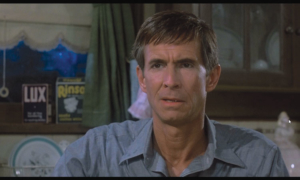
This led you to write Cloak & Dagger and then write and direct Fright Night, which both have allegiances to Hitchcock. How did those stories evolve?
I’d done [1984 spy adventure] Cloak & Dagger with Richard Franklin, which was kind of a remake of The Window, which was a juvenile version of Rear Window and the quintessential ‘boy who cries wolf’ story about a kid witnessing a murder next door. When I invented Jack Flack, [played by Dabney Coleman] Henry Thomas’ imaginary friend, the story took off in its own direction. After Cloak & Dagger, I said to Richard: ‘If you really want to make a story about The Window and really modernise it, what you do is take a teenage horror fan and have him look out the window and become convinced that his next door neighbour is a vampire!’ Richard didn’t react at all. It didn’t do anything for him but it stayed inside my head and I couldn’t get rid of the idea.
How did you decide you wanted to direct it?
Richard understood suspense and could be very visually interesting in a very Hitchcockian way. However, Richard was busy on a horror film called Link and [for various reasons] Michael Winner ended up directing a movie of mine called Scream For Help. Michael didn’t have a clue about suspense and thought the more dialogue you cut the stronger the movie became. That film became incomprehensible and a disappointment. So, after that experience, I decided I wouldn’t have my work trashed like that again and that if I wrote another one, I would direct it too.
So, I had the concept of the boy looking next door and seeing a vampire and he’s a horror movie fan, however I didn’t really have a story. Then, I thought to myself: ‘If I were a horror movie fan and became convinced that the guy next door is a vampire, who would I go to for help?’ That’s when I thought: ‘Well, I would go to a horror movie host!’ When I grew up, the only way you could watch horror movies on television was on what they called ‘The Friday Night Frights’, which always had a host who was terribly corny: like Christopher Lee on a very bad day! The sets were always tacky and failing apart but they were a lot of fun. The minute I had the character of Peter Vincent in my head I was in love with the story.
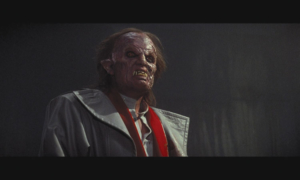
You originally wrote the Peter Vincent role for Vincent Price didn’t you?
Yes, I wrote it with Vincent in mind. Vincent and Christopher Lee were the two horror loves of my life. However, when I finished writing it I found out that Vincent wasn’t in good health, so I got Roddy McDowall and he was absolutely wonderful. He had me over for dinner one night and his other guests were Vincent Price and his English wife Coral Browne. But Vincent didn’t want to talk about his horror movies. He was more interested in talking about art and haute cuisine! I ended up having lunch with Christopher Lee too. He was as hammy as you can imagine: he was Peter Vincent except he was deadly serious!
Fright Night has a considerable LGBTQ+ following. Were the apparent homosexual undertones intentional?
I was oblivious to it. However, there’s the scene where Jerry Dandrige [Chris Sarandon] traps Evil Ed [Stephen Geoffreys] in the alley and says: ‘Here, take my hand and I’ll make sure none of those kids who bully you and make your life so miserable will ever bother you again!’ By the time I shot that scene I knew that Stephen was gay but I didn’t know when I cast him. It somehow made it easier to make an anti-bullying statement with him in it. And for all those kids who were gay and didn’t say it in high school, it gave them a bit of support I like to think.
How did you become involved as director on the original Child’s Play?
A producer came to me with it. He had a deal at United Artists. It was like an episode of The Twilight Zone. It was originally called ‘Blood Buddies.’ The little boy made the doll a blood buddy and whenever he fell asleep, the doll got up and killed the people he didn’t like, including a teacher and a dentist. I sympathised, but it wasn’t a movie. There was no one to root for and it wasn’t scary. It all started to come into place when I created the serial killer Charles Lee Ray and had him transfer his soul into the doll. The drive of the piece comes from Charles/Chucky’s desire to avenge himself on his accomplice who left him to be arrested in the opening chase. The second beat of that motivation was Ray finding out if he didn’t get his soul out of the doll in time, he would be trapped there forever.
Was Brad Dourif always going to provide his vocals to Chucky too?
Using his voice was an open issue at the time. I tried to treat it with an electronic filter, like ‘Talky Tina’, in the Twilight Zone episode. Remember how that doll sounds? Treating it electronically in post didn’t work. I also tried female voice actresses, most notably Jessica Walter from Play Misty For Me. That didn’t work either. Finally, I used Brad doing Chucky, plain and simple, and, as we all know, it worked! It worked because I gave the doll humour. The “fuck you” in the elevator, after the old woman comments on how ugly Chucky was, was added in post. It brought the theatre down every time! That was because in previews you could feel the audience love the doll and fear it the more ribald and funny it became. That’s why I had Brad add as much funny nastiness as he could in the voiceover. The humour was there in my original script but the previews led me to play the hell out of it.
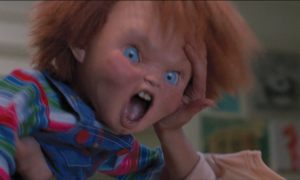
You also adapted and directed a couple of Stephen King novels. Looking back what are your thoughts on The Langoliers?
Well, I did it as a four-hour mini-series and I thought it was a terrific ensemble drama. However, it’s been a little laughed at because it was just that moment that CGI was coming in and the Langoliers themselves now look corny because of the advancement in digital technology. But excluding that, the actors and the story I thought were very good.
Then you adapted King’s Thinner. What drew you to that project?
I turned down The Stand to do Thinner because I thought it was a much more interesting character study. It wasn’t commercially successful but it seems to have had quite an afterlife because people bring it up. It’s got a terrific central performance from Robert John Burke but I had a bitter ending. The film tested brilliantly up until the last two or three minutes… but the audience hated the ending! They hated seeing Billy lose!
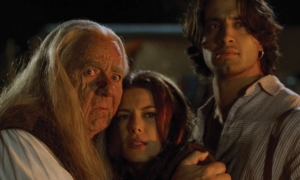
Why do you feel they responded so strongly to that?
I think Robert John Burke had done such a terrific job of acting that the audience felt sympathy and wanted him to win. And they were horrified that he lost and the moral of the tale is that ‘the moral jellyfish gets squished in the end’. In other words it’s a bitter ending. However, that was Stephen King’s original intent. The audience hated it, therefore I did the ending that everybody seems to be happy with where [Billy] says to the doctor, [who’s been sleeping with his wife]: ‘Come on in. Have a piece of pie!’ and gets his revenge. I’ve had some people say that Thinner is my best movie but I think the two that will go on after I’m gone are Fright Night and Child’s Play.
Recently you’ve written a novel called The Notch. Can you tell us more?
I wrote a short story that I couldn’t get out of my head. It concerns a boy who appears out of the notch between a table mesa and the sun. He never talks but whomever he touches is ‘healed’, whether it’s a hangnail or MS. He creates a social media sensation when he brings a dog hit by a car back to life, but nobody catches his face. Four teenage thieves almost run down a kid that matches the description. He doesn’t talk or react.
They think he’s autistic. However, they owe [money] to a loan shark who has stomach cancer and they decide to convince him the kid is ‘The Boy’. The loan shark makes the deal, but the cancer is still there after the boy touches him. He throws the thieves out with the kid, only to discover soon after his tumour has disappeared. He realises the kid is worth a fortune and sends his thugs after the thieves to get him back. As the word spreads the whole world wants him…
It’s a moral choice, but it’s also a story about hope.
The Notch by Tom Holland will be available from Cemetery Dance. Psycho II is available on Blu-ray from Arrow Video. Fright Night is available on Blu-ray from Eureka. Child’s Play is available on Blu-ray from Universal. Stephen King’s Thinner and Stephen King’s The Langoliers are available on DVD from Paramount.
